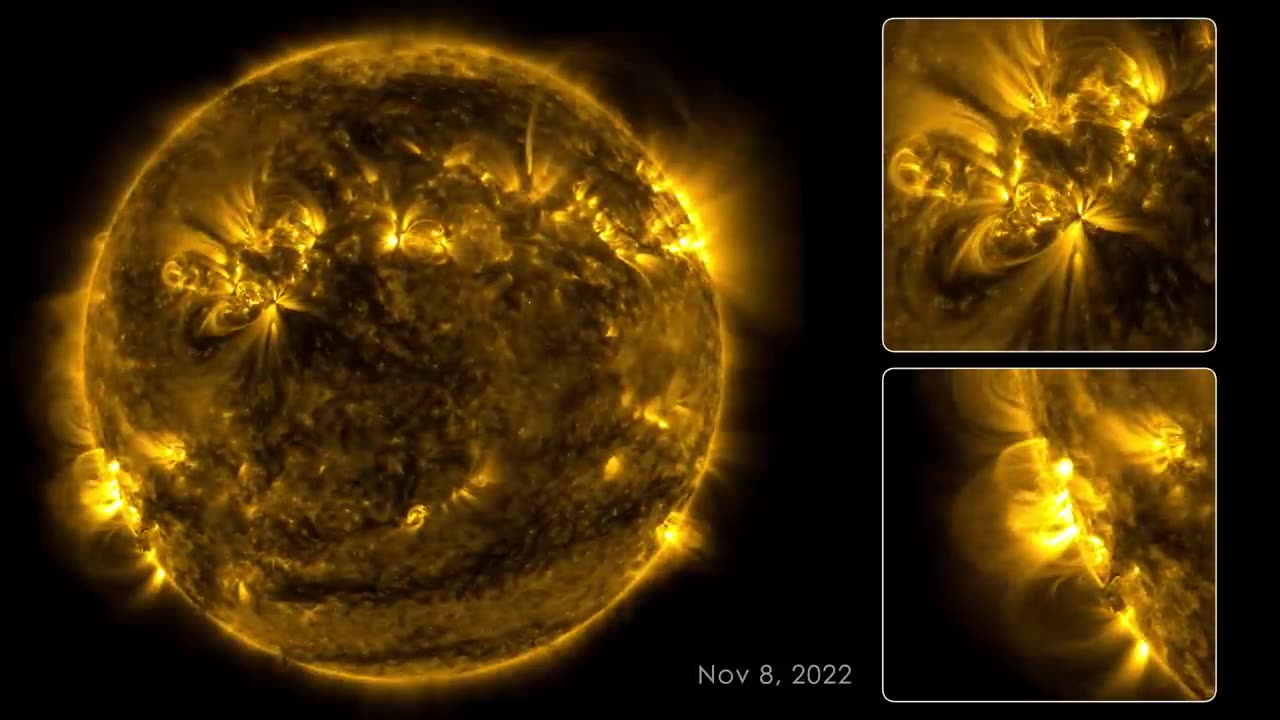Premium Only Content

Sun: 133 Days on The Fire Ball SUN
This time-lapse presentation chronicles the solar activity observed between August 12 and December 22, 2022, through the lens of NASA's Solar Dynamics Observatory (SDO). Positioned within Earth's orbital plane, the SDO has diligently captured imagery of the Sun at a resolution of 4K x 4K for an impressive duration of nearly 13 years. This extensive visual dataset has been instrumental in facilitating a multitude of pioneering discoveries pertaining to solar dynamics and their intricate influence on the broader solar system. Operating with a triad of scientific instruments, the SDO routinely captures solar images at an interval of 0.75 seconds. Among these instruments, the Atmospheric Imaging Assembly (AIA) stands out, providing imagery at 10 distinct wavelengths of light every 12 seconds.
This 133-day observation period, prominently showcased in the present recording, is accentuated through imagery captured at a wavelength of 17.1 nanometers. This wavelength corresponds to the extreme-ultraviolet range and effectively unveils the Sun's corona, its outermost atmospheric layer. The condensed visual narrative, achieved through the compilation of images separated by 108-second intervals, encapsulates a span of 133 days or approximately four months of solar phenomena, condensed into a succinct 59-minute format. This presentation captures the dynamic passage of luminous active regions across the Sun's disc, with the Sun's rotation, occurring at an approximate interval of 27 days, distinctly evident.
These luminous regions bear significance, representing zones of heightened magnetic activity that entrain incandescent plasma. They are also the wellspring of solar flares, characterized by intense flashes resulting from the reconfiguration of magnetic fields, a process termed magnetic reconnection. While the SDO maintains its continuous vigil on solar events, instances of data loss are recorded, attributed to Earth or the Moon traversing between the spacecraft and the Sun, leading to temporary interruptions in imaging. Technical anomalies or data inaccuracies similarly account for intermittent periods of darkness. Noteworthy to mention is the SDO's remarkable data transmission capacity, sending 1.4 terabytes of information to the terrestrial station each day.
The inclusion of certain off-center solar images was necessitated during the instrument calibration phase. It is anticipated that SDO, alongside its NASA counterparts, will sustain its commitment to solar observation, thereby enriching our comprehension of cosmic context and advancing strategies for astronaut safety and asset protection within space environments.
The musical accompaniment, a continuous arrangement sourced from Lars Leonhard's "Geometric Shapes" album, graciously authorized by the artist, complements the visual narrative. While the entirety of this video is open for distribution without restriction, discernment is advised with regards to the utilization of music and specific imagery, which may entail distinct permissions and use considerations.
In a visual description of the footage, the left segment of the frame encapsulates the Sun in its entirety, characterized by a nuanced golden yellow hue. Intricate solar features, encompassing luminous areas and wispy extensions, grace the Sun's surface. This segment effectively conveys the Sun's steady rotation, with each full revolution taking 12 minutes within this time-lapse depiction. The observable regions of heightened activity exhibit a dynamic interplay of shifting and flickering reminiscent of petite fires. The right segment of the frame is allocated for two delineated squares outlined in white, each featuring magnified depictions of captivating sections of the Sun's surface.
-
 7:55:00
7:55:00
SpartakusLIVE
8 hours agoSpecialist EASTER EGG at the Tower of Power || Duos w/ @sophiesnazz, Quads Later?!
78K2 -
 2:37:59
2:37:59
vivafrei
15 hours agoEp. 267: L.A. Burns AGAIN! Patel on Rogan! Elon's Meltdown! 2nd Amendment Win! SCOTUS & MORE!
118K197 -
 2:31:21
2:31:21
TheSaltyCracker
7 hours agoUnleash Rooftop Koreans ReeEEeeStream 06-08-25
136K270 -
 2:44:00
2:44:00
IsaiahLCarter
9 hours ago $3.24 earnedAPOSTATE RADIO 017: Ranking Marxist Pluralities, with Seneca Scott
88.8K2 -
 1:19:28
1:19:28
Sarah Westall
7 hours agoDeep State Operations, Brain Orgonites, Infowars in the Early Years w/ Jason Bermas
98.1K18 -
 2:37:49
2:37:49
Cavs_Arcade
6 hours ago $0.52 earnedWeekend Vibes! 🍺🍕 | RE4 Remake | #18 |
36.7K -
 2:08:10
2:08:10
Nerdrotic
8 hours ago $6.59 earnedMalaysian Flight MH370 and Zero Point Free Energy with Ashton Forbes | Forbidden Frontier #104
81.5K6 -
 18:39
18:39
Exploring With Nug
1 day ago $6.20 earnedSunken Corvette Recovered From River! Massive Catfish Surprise in the Trunk!
48.2K10 -
 16:28
16:28
Clownfish TV
2 days agoDoctor Who Billie Piper BACKLASH! They're DESPERATE for Disney to Renew?!
43K11 -
 2:12:45
2:12:45
Tundra Tactical
1 day ago $12.75 earned🛑 LIVE The Worlds Okayest Firearms Live Stream
41.1K2